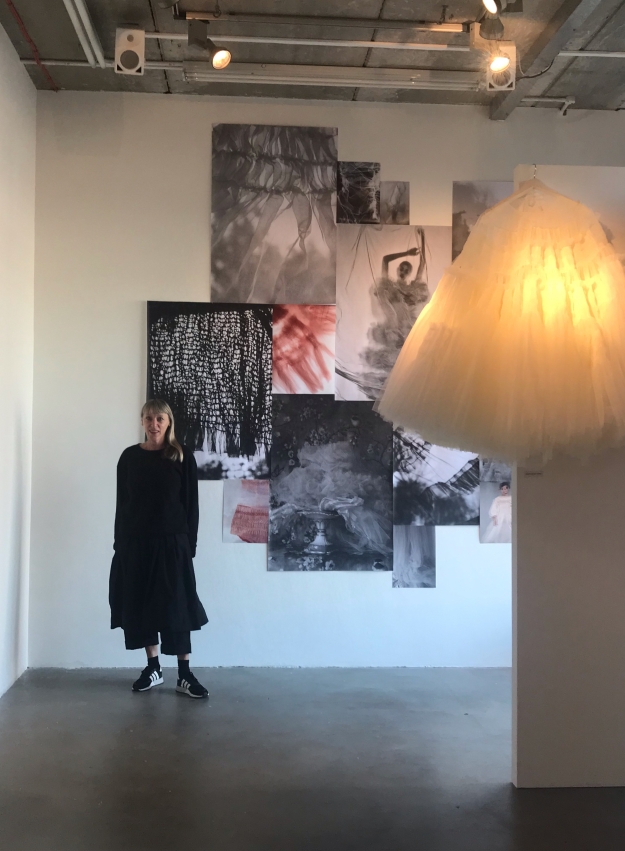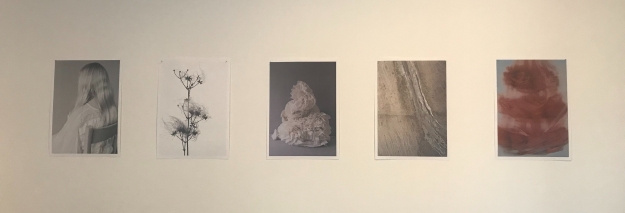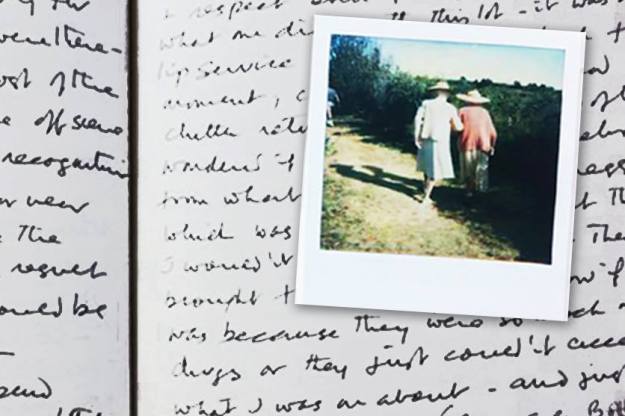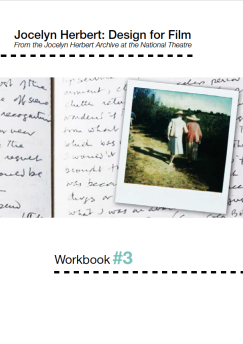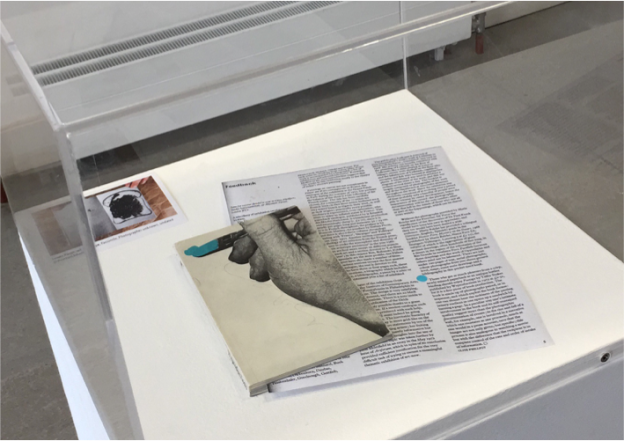A conversation with MA Curating and Collections students
Jiaying Gao, Celina Loh, and Hao Long

MA Curating and Collections student Cara Salmon installing the recent MACC exhibition ‘Ballets Russes: Concealed Histories’. Image © David Dibosa
A few weeks ago, the students from MA Curating and Collections were due to open their interim exhibition, ‘Ballets Russes: Concealed Histories’ in the Triangle Space at Chelsea College of Arts. As the Covid-19 emergency escalated, they had to adjust their original plan to a new format and a new space, delivering an exhibition display instead in the Exhibition Studio Workshop. The College closed shortly thereafter so the exhibition was never opened to the public (although you can read about and see more of it here).
We spoke to MA Curating and Collections students Jiaying Gao, Celina Loh, and Hao Long about their original plans for the show, and about their thoughts on their future as students and curators emerging into what will be a profoundly changed art world.
Could you talk about the process of researching for and curating the Ballets Russes show how it was supposed to be, and what changed with the new display? Were there aspects you focused on initially, that you managed to highlight in the final display as well?
CL: Our interim show titled Ballets Russes: Concealed Histories intended to focus on the dance troupe’s textile pieces, showcasing myriad details from the costume designs to the wear and tear that are usually hidden in conventional textile displays.
On the morning the textiles were scheduled to arrive, we received the news that we couldn’t display them because the safety of the collection items, on loan from the Archive and Special Collection Centre at London College of Communication, could not be guaranteed in the circumstance of a lockdown – so we had to make a quick decision and turn the show into an exhibition display. We utilised the photographs of all the materials we had thus far, to present a show that could be virtually viewed via online platforms.

Inspecting the Ballets Russes collection at LCC with Jacqueline Winston Silk. Image © Carolina Pelletier Fontes
JG: We wanted to exhibit the different textures, details, and flow of the costumes, to show the imperfections in the outfits that indicate a certain history behind the garment, the dancer’s body, and behind the influential ballet company. The project would examine how these costumes, and even the most minute of their details, offer a historical and contemporary reconsideration of the ballet troupe in terms of its design, choreography, and music.
CL: This mainly derived from our research on spectrality within theatre performances, which focuses on the absence and presence of performers and narratives. One of the curators, Dana Chan, thought it was pertinent to highlight this aspect, with the Covid-19 emergency that consequently closed most public spaces:
As with the body and dress, movement, and stillness, we note the certain absences and presences within this space. However, in the current situation of a public health crisis, we are reminded of the collective endeavour that is art.
HL: That tension between absence and presence was our focus throughout our curating process, the ‘absence of body’/ ‘absence of stage’ was the lens through which we looked at these costumes. When the costumes are presented and viewed separately, on the one hand, there is always an absence, they are like a container. On the other hand, they are probably one of the few things that are still alive of the stage of those times, the remnants of the memory. Our research also focused on orientalism, modernism, and transculturation manifested in the practice of the Ballets Russes, which can be read in the various elements that constitute the important components of ballet – choreography, music, props, and of course costumes.
What do you think, as students and emerging curators, the repercussions of this situation will be on the arts sector, and on art practitioners and curators? What do you think will change and shift (if at all!) and what do you see as the biggest challenges, and opportunities, for curators?
CL: I think the impact of Covid-19 on the arts sector is conflicting. On one hand, live events and performances had to be cancelled on top of cultural institutions being forced to close. The termination of art fairs and exhibition opportunities have a heavy impact on the economy whilst hindering emerging practitioners who strive to make a name in the art scene. On the other hand, however, the crisis has shown how art as a culture is more relevant than ever, uniting people across the globe. With millions worldwide confined at home, curators, artists and other art producers are cooperating in multitudes of ways online, to persevere with showcasing work and forming alternative approaches to curating, among other things. Personally, it has presented me with an opportunity to view and adapt my curatorial practice, which I wouldn’t have done if not for the pandemic. It has vastly altered how the convoluted art world functions, which perhaps isn’t too bad of a thing after all.
HL: I have always felt that contemporary art is about to reach a turning point, or it has been a trend for a long time, closely related to the online world or to some level of technology that has gradually become the norm of life. The current health crisis is a catalyst, and unsurprisingly, we see art fairs and mega art institutions develop online exhibitions. The rapidity with which they reacted also suggests that they were ready before this crisis happened.
Quite a few of these online shows are predictable, and if they want to perfect them, galleries will probably have to work with companies that really have the technology for it, but how this will reshape art institutions is unpredictable. Instead, think it is time for digital art or net art to embrace this moment. Online exhibitions are likely to become more like games, in which the audience will act as the player. This is already a big topic, and it is both an opportunity and a challenge. Curators have the opportunity to step out of an institutionalized curatorial context and also face the challenge of the trap of consumerism. I would not be surprised if I saw a TikTok-like exhibition.
When an art institution in New York launches an online show that is equally accessible to local and global audiences, other changes and discussions are bound to take place. The constant emphasis on ‘presence’ in the art world is going to be challenged, and how it is defined when it is not in a physical space, how that definition will be reinvented. Of course, everything depends on how long this outbreak lasts. However, art will continue to happen, people will just focus on where and how it happens.
JG: For artists, this situation allows for a platform transformation from offline to online, which means that artistic works will be digitized and widely circulated on the internet. I think it is also an opportunity to see more artworks in digital forms, which provides new challenges for their creation and archiving.
As for the curators, I think they will further promote an immersive remote collaborative design platform, and other industrial applications: online virtual gallery, online virtual exhibition, online panoramic exhibition. It would be desirable to keep the physical business activities and online business activities in parallel, but in any case, the Internet and online trading has been a challenge for the traditional art market for a while and more so now. I think we can take advantage of this period of pause to maintain and update the facilities in the gallery. In the future, the exhibition will have online communication with the organisers, curators, constructors, and transporters through this platform, to timely solve various problems and improve work efficiency.

Archive and Special Collections curator Jacqueline Winston Silk showing Ballets Russes material. Image © Celina Loh
What has been on your mind lately, and is there a thought, a text or artwork that has inspired you and that you think you will carry with you in your future practice?
CL: Lately, Jurgen Habermas’ ‘Structural Transformation of the Public Sphere’ has been running through my mind a lot and has profoundly stimulated my thoughts. As a curator, I have always been interested in improving viewers’ engagement thus the study of publics is crucial in my curatorial practice. Habermas has mentioned the prospect of a universally accessible public sphere if there exists a universalisation of interest, leading to a public that unites on the same level to critically engage with one another. Although it may be naive, I can’t help but feel like this health crisis is contributing to the formation of a universally accessible public sphere, should it succeed or fail. And if it were to succeed one day, what is the function of art in that condition?
JG: I have been interested in the potential of the digital platform and its broad market, and the many galleries setting up online exhibitions beyond space, distance and transportation. The combination of digital and art that will become a new trend in the future, made me want to research how to create exhibitions on the internet, how to use the digital form to fulfil the curator’s ambition to interpreting an exhibition well.
HL: I wasn’t there when China was the epicentre, and what I observed about the art world in the UK at the moment is that I feel there is a greater sense of isolation and loneliness among artists here. One could think that, in the face of such a major crisis, the arts are useless – however, it is not meaningless for artists, curators or any art practitioners to be witnesses of this situation. Different regions may really need to establish an effective dialogue through self-description and a willingness to understand the description of others, and that is what art can do. Also, there were some things in the past weeks that resonated with my research; the spontaneous group singing of the Italian people on their balconies, or Britons applauding the NHS etc. This kind of collective behaviour, which is closely related to sensibility/empathy/politics, is signalled by sound and is something I have been very interested in. Finally, I have been coming to terms with the fact that this is a marathon, a time when mental health is as important as physical health. But we are all much stronger than we thought and most importantly, in a bigger sense, we are never alone.


